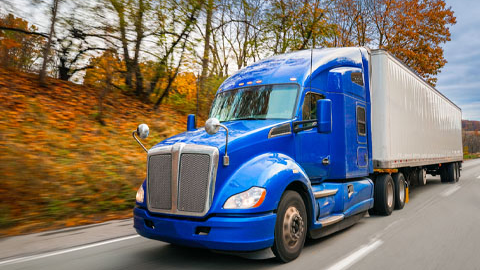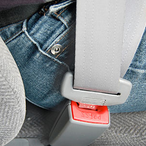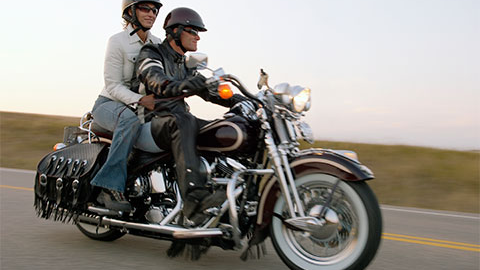Yielding the Right of Way

Failure to yield the right of way is a factor in many serious crashes. For most types of vehicles, the risk of being involved in a failure-to-yield collision is greatly increased at intersections and while merging or changing lanes. For large commercial vehicles, several unique vehicle characteristics can heighten this risk:
- Extended vehicle length increases the amount of time required to clear an intersection and the amount of space needed to turn.
- Larger vehicles tend to accelerate slowly, further increasing the amount of time required to clear intersections.
- Greater stopping distance can limit the driver’s ability to slow down or stop to avoid collisions.
- Blind spots can obscure your view while merging or changing lanes.
- For passenger-carrying vehicles, passengers can be an additional source of distractions.
Intersections
Use caution when approaching and crossing both controlled and uncontrolled intersections. Never assume you have the right of way. Some precautions to help you avoid these types of collisions include:
- Using the left-right-left scanning technique, survey the road ahead and to each side for other motorists who may fail to yield the right of way.
- Be prepared to stop by taking your foot off the accelerator and covering the brake. This can help reduce your speed and shorten reaction time if you need to act quickly to avoid a collision.
- Enter an intersection only if you are certain you can pass completely through it before the traffic light turns red. Be prepared to stop if you are uncertain when the light will change.
- Be alert for motorists who intend to turn in front of you. A driver’s turn signal may not be the only indication that he or she is planning to turn.
- Have a clear view of oncoming traffic before entering an intersection. Don’t assume approaching vehicles will stop.
- Allow enough time to safely cross or turn at intersections, keeping in mind that it can take larger, heavier vehicles longer to completely clear intersections.
- If two vehicles reach an uncontrolled intersection at the same time, the general rule is to yield to the vehicle on the right.
Right and left turns
Turning at busy intersections can be extra hazardous. For one, it may be difficult to judge when entering or crossing an intersection is safe. This is particularly true at intersections where there are no traffic signals or where your view of oncoming traffic is limited.
Making left turns across busy intersections can sometimes be risky. Making a series of right turns or turning at another location could offer a safer alternative. However, if a left turn is unavoidable, make sure you have the time and space to complete your turn without impeding oncoming traffic. Keep your wheels pointed straight ahead while waiting to turn so you won’t be forced into oncoming traffic if you are rear-ended.
Merging and changing lanes
Entering and leaving the flow of traffic can mean yielding the right of way to other vehicles. For large commercial vehicles, these maneuvers can be risky. Precautions to help you avoid merging and lane-change collisions include:
- Use your turn signals to show your intention to merge or change lanes.
- Check your mirrors and blind spots before changing lanes or merging.
- To avoid changing lanes unnecessarily, drive in a lane where you can maintain a safe, consistent speed.
- Avoid changing lanes abruptly. Keep a safe following distance so unexpected traffic stops will not be a surprise.
- When entering the highway, adjust your speed to match the flow of traffic and watch for a safe space to merge. Vehicles entering the flow of traffic are usually required to yield the right of way.
- Be courteous. Provide a space for vehicles entering the flow of traffic so they can merge safely.
Other right-of-way hazards
- Pedestrians. Yielding the right of way also means yielding to pedestrians at crosswalks, and intersections. Watch for children near the roadway, since they may forget to look for vehicles before crossing the street.
- Emergency vehicles. Always yield to emergency response vehicles. Some cities allow emergency vehicles to control traffic signals remotely. In these areas, traffic signals may change out of sequence when emergency vehicles are nearby. Many states have passed “move-over” laws requiring motorist to either mover over or slow down when passing stopped emergency vehicles.
- Work zones. Slow down before entering work zones. Be cautious of other drivers who might attempt to merge in front of you unexpectedly if lanes end or the roadway narrows. Increase your following distance to provide more time to react if traffic stops suddenly. Yield to flaggers and construction workers. Watch for slow-moving construction vehicles entering and leaving the roadway.
- Railroad crossings. Always yield the right of way to trains. Obey crossing signals at all times and never attempt to beat a train to a railroad grade crossing. Be aware that large objects, such as trains, can appear to be traveling more slowly than their actual speed, so it can be easy to misjudge how much time you have to cross safely.
As a professional driver, it is important to monitor your surroundings and scan the roadway for potential hazards. To avoid failure-to-yield collisions, approach intersections cautiously and watch for drivers who may fail to yield the right of way. Signal early and communicate your intentions clearly. Wait for a safe opportunity to turn or merge with the flow of traffic, and be courteous to other drivers who are attempting to do the same. Observing these simple safety precautions can help keep you and other motorists and pedestrians safe.
DOC#: LCT206




